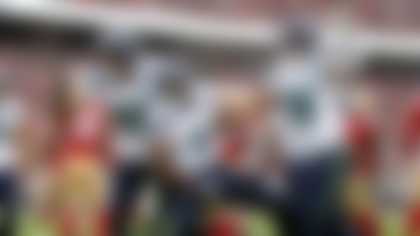The Los Angeles Rams are back in the Super Bowl three years after Sean McVay's first opportunity to hoist the Lombardi Trophy. The organization leaned all the way into its "stars and scrubs" roster construction over the past year, leveraging future draft picks to acquire Matthew Stafford and Von Miller.
Armed with a new quarterback, McVay staged a renaissance of his offense. The Rams now stand one win away from completely validating a strategy that currently has them in line to go seven straight drafts without making a first-round pick. To examine why the Rams felt such a gamble on a quarterback who had never won a playoff game was necessary, let us explore how they got to this point.
McVay had taken the league by storm in his first two seasons as head coach, building a well-oiled machine of an offense. With McVay stemming from the Shanahan coaching tree, was a dominant outside-zone run game with horizontally-stretching play-action concepts built off the same movement. The Rams averaged 32.9 points per game in 2018, the 10th-highest figure in the Super Bowl era. The current Rams offense did not come close to those heights, averaging a respectable -- but far from historic -- 27.1 points per game in the 2021 regular season.
But is this year's team better constructed to win when it matters most?
In terms of efficiency, the biggest difference between the two Super Bowl offenses lies in the run game. In 2018, the Rams achieved a 50.4 percent success rate on designed runs, the only offense that has topped 48 percent in the Next Gen Stats era (since 2016). Reigning Offensive Player of the Year Todd Gurley found ample opportunity to gash defenses for consistent gains behind a stacked offensive line which had no starters miss a game.
The Rams would soon find out Robert Frost's famous idiom -- Nothing gold can stay -- definitely applies to the NFL. With Gurley aging, the roster turning over and defenses adjusting, Los Angeles' run game stagnated in the ensuing years. This season, the Rams ranked a middling 18th in success rate on designed runs (40.6 percent). The only resemblance between the two units at this point is the scheme and bookend tackles Andrew Whitworth and Rob Havenstein. The Rams did lean on another trade acquisition, Sony Michel, to help stabilize the offense after a midseason three-game losing streak, feeding Michel at least 18 carries in each of their last six games of the regular season. However, the ground-game renaissance was short-lived -- Los Angeles hasn't posted a success rate on designed runs above 30 percent in their last four games.
On the other hand, the passing games of both iterations of these Super Bowl offenses look remarkably similar, at least to a box score scout. Stafford posted roughly the same yards per attempt and passer rating in 2021 as Goff did in 2018. Diving a level deeper into how they produced, the two quarterbacks averaged a comparable throw depth and were in the same ballpark in how much of their yards came after the catch. Even their more advanced efficiency metrics were barely distinguishable.
| Y/A | Rating | Air Y/A | YAC% | EPA/Dropback | Success rate | |
|---|---|---|---|---|---|---|
| Goff (2018) | 8.4 | 101.1 | 8.8 | 47% | +0.16 | 49.7% |
| Stafford ('21) | 8.1 | 102.9 | 8.5 | 46% | +0.18 | 49.6% |
Despite the similarities between Stafford's and Goff's raw numbers, it is safe to say that this year's Rams offense put more responsibility on Stafford's shoulders because of the aforementioned lack of a reliable run game. When Stafford played up to his talent level, Los Angeles looked unbeatable. When he went through , the team followed its .
Stafford has always been a volatile quarterback, and his arm talent gives him the confidence to force some throws that he probably should avoid. Taking care of the ball proved to be an issue this season, as he threw a league-leading 17 interceptions -- four of which were returned for touchdowns. That's as many pick-sixes as Goff threw during as the Rams' starting quarterback. During the nadir of L.A.'s season, these turnover issues had those who thought the Rams gave up too much for Stafford taking victory laps.
While Stafford has his flaws, the Goff-led version of this attack had run its course. An offense that relies on scheme and personnel to elevate its quarterback can only last so long until defenses start to catch up. The McVay/Shanahan coaching tree that has spread through the league is famous for building an offense with training wheels for the quarterback. But what happens when defenses find a way to tear off the training wheels?
In Super Bowl LIII, Bill Belichick and Brian Flores revealed the blueprint for stopping Los Angeles' offense on the largest stage in the sport. The Patriots eliminated the double teams essential to the Rams' outside-zone runs by aligning with six defenders on the line of scrimmage in . New England used these six-man fronts on 39 percent of plays that day, per NGS, the first time L.A. had faced anywhere near that usage in a game under McVay. The rest of the league took notice -- the Rams faced six-man fronts on 16 percent of plays during the following two seasons, the only offense over 14 percent.
On the back end, the Patriots aligned with two-high safety shells and broke tendency by dropping into zone coverage instead of their typical man-heavy scheme. New England was able to pass off and take away the crossers that had driven explosive plays for the L.A. passing attack. By eliminating the run game and forcing Goff out of his comfort zone, the Pats held those Rams to their lowest point total of the season, with the 13-3 final giving New England its sixth Lombardi Trophy.
| Coverage rate faced | Man | Zone | Middle of field open | Middle closed |
|---|---|---|---|---|
| 2018 Rams offense | 31% | 60% | 31% | 60% |
| 2021 Rams offense | 22% | 70% | 48% | 45% |
The 国产外流网is a copycat league, and as this defensive recipe made its rounds over the next two seasons, it became clear Goff couldn't lead the offense back to a Super Bowl level without his training wheels. The play-action efficiency fell off a cliff, and the crossing-route windows Los Angeles used to feast on were no longer available. The Rams needed a quarterback who could elevate this offense beyond its scheme.
As mentioned above, Stafford has brought the Rams' passing attack back to the level it was producing at in 2018. This becomes much more impressive when you realize he's performed at this level without the systematic support Goff was afforded. McVay didn't need to rely on play action as much this season -- in fact, the Rams ranked 22nd in play-action rate (23 percent), their first season outside the top five since McVay took over. A staggering 84 percent of Goff's passing EPA came on play-action dropbacks in 2018, compared to just 49 percent for Stafford this season.
| EPA/Dropback | No play action | Play action | vs. blitz | Third down | Vertical routes |
|---|---|---|---|---|---|
| Goff (2018) | +0.04 | +0.37 | +0.08 | +0.07 | +0.38 |
| Stafford ('21) | +0.12 | +0.37 | +0.65 | +0.29 | +0.76 |
Another important factor for the 2021 Rams: Stafford makes defenses pay when they bring pressure. His serves as a counter punch to the defensive adjustments that plagued Los Angeles in the years before his arrival. With Goff at the helm, the Rams were blitzed at the sixth-highest rate from 2017 through 2020. Defenses couldn't do that against Stafford -- and as a result, he was blitzed at the third-lowest rate this season (23 percent). Stafford was able to identify blitzes and get rid of the ball quickly (2.52 seconds) before the pass rush had the chance to get home (often ). Goff's average time to throw in 2018 (3.02 seconds) was a half-second slower against the blitz, and as a result, he was pressured at twice the rate.
The difference in playoff performance, above all else, justifies the Rams' decision to make the trade. The skills needed to win in the postseason are a different animal completely. Opposing defenses are more talented and are armed with a season's worth of plays to study. As a result, offenses that rely more on scheme than talent will be better prepared for and easier to snuff out. The margins for error shrink and the throwing windows get tighter. The playoffs reveal the distinction between a system quarterback and a quarterback who can ascend beyond the play design to -- whether that come via arm, legs or timing.
| Playoffs | Comp% | Y/A | TD:INT | Rating | EPA/Dropback | Success rate |
|---|---|---|---|---|---|---|
| Goff (2018) | 55.7 | 6.7 | 1:2 | 71.7 | -0.10 | 39.6% |
| Stafford ('21) | 72.0 | 9.1 | 6:1 | 115.6 | +0.35 | 56.2% |
The 2021 Rams have made the Super Bowl because of , whereas the 2018 Rams' playoff run came in spite of Goff's performance. At the end of the day, the Rams acquired a quarterback who can stand tall with blitz pressure in his face -- at a moment with everything on the line -- and hit his receiver in stride:
Follow on Twitter.












